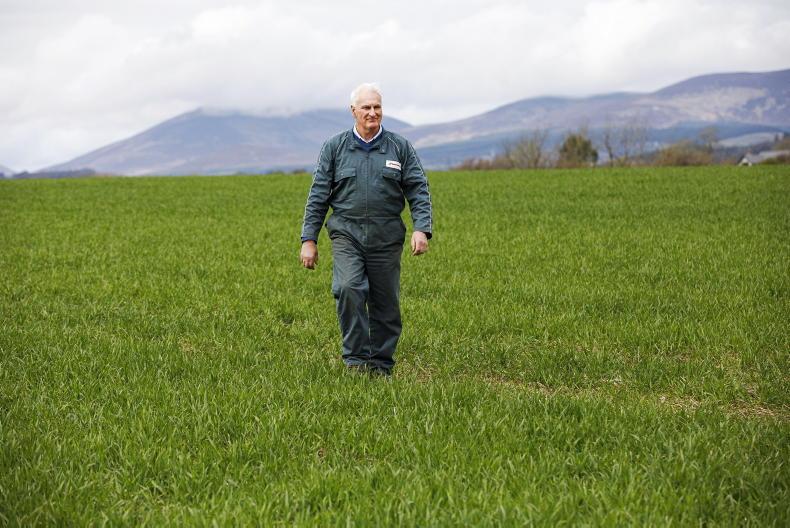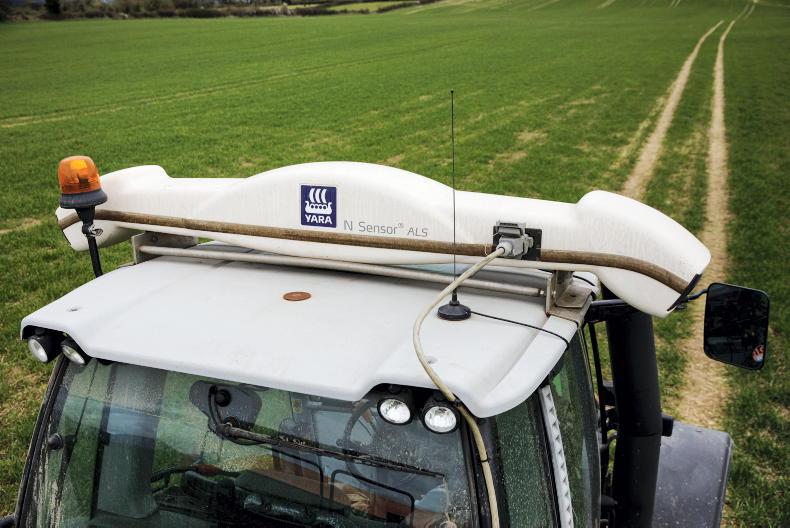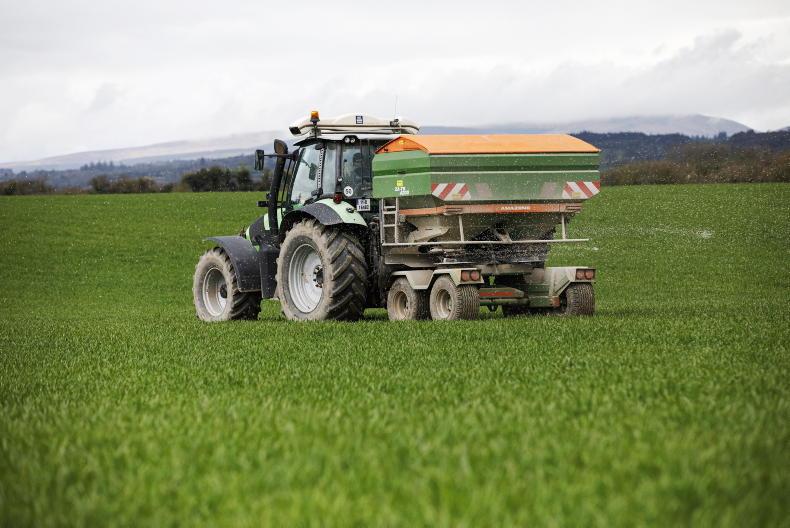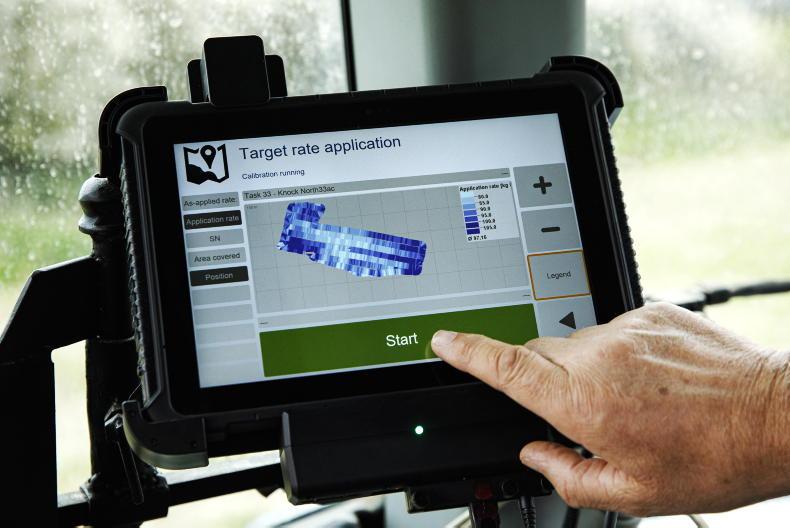This year’s Arable April campaign is focusing on sustainability in the tillage sector.
The positive sustainability profile of the sector has gained a lot of publicity recently.
The carbon footprint of the tillage sector is about 14% of that of an average dairy farm, or around 30% of a typical beef enterprise.
However, with emission reduction targets for agriculture looming, tillage farmers will have to look at where they can further reduce their on-farm emissions.
Emissions from the spreading of nitrogen (N) and lime accounted for 73% of CO2e direct emissions in the tillage sector, so this is an area which needs attention.

John Collins of Cappoquin Estate walking a crop of Graham winter wheat. / Donal O' Leary
Earlier this week, the Irish Farmers Journal spoke with John Collins, who has been using a YARA N-Sensor to help better manage his nitrogen usage on crops.
Having used the system for over a decade, we caught up with him to hear of his experience with the technology.
Organic manures
John is the tillage farm manager of Cappoquin Estate in Co Waterford. The estate consists of a 250-cow dairy farm and 233ha of tillage.
He grows a range of crops, including winter wheat, winter barley, winter oilseed rape, spring oats for porridge and forage maize.
Around two-thirds of his crops are established via minimum-tillage, with the remainder ploughed on rotation.
John regularly uses organic manures on the farm, including slurry from the dairy herd and broiler manure.
He explains that when using organic manures, it’s difficult to know exactly what is available to the crop and how much chemical N is needed.
He first came across the YARA N-Sensor technology 10 years ago at the UK Cereals event.
From there, he began trailing the system to learn how it could integrate into the farm. At the time, this was the first system of its kind in Ireland.
Ten years later, it now forms a pivotal part of the farm's nutrient management plan.
N-Sensor
The N-Sensor is a well-known piece of technology. The cab-mounted sensor scans the crop canopy and measures the crop’s light reflectance at specific wave bands related to the crop’s chlorophyll content and biomass.

The Yara N-Sensor / Donal O' Leary
This measurement is then fed back to the Yara N controller, which adjusts the application rate of chemical N on his fertiliser spreader accordingly.
John explains that for barley, oats and other crops, the sensor adjusts application N rates within pre-set parameters.
However, for oilseed rape and wheat crops, the sensor is able to determine the absolute N requirement for the crop.
Experiences
John finds that the system allows him to make better use of his chemical N, as in it is applied move evenly throughout the field.
That means that crops in weaker areas of the field will receive more N than stronger areas of the field. This results in more even crops and improved crop yields at harvest time, he remarks.

John Collins of Cappoquin Estate using the Yara N-Sensor
However, the biggest benefit from using the technology is that it helps him account for the variability of organic manures when spreading chemical N. This means that over-application of N is rare, meaning crops are rarely lodged.
“It helps take a lot of the guesswork out of organic manures,” he said.
Optimise instead of minimise
The use of organic manures on the farm has help to reduce the amount of chemical N required by his crops.
When asked has the sensor technology helped to reduce chemical N usage further, John said that the reduction was minimal.

John Collins of Cappoquin Estate using the Yara N sensor for variable application of nitrogen on a crop of Graham winter wheat at GS30.
“It hasn’t led to a massive reduction in chemical N use, but I know the fertiliser which we do use is being used much more sustainably. It’s going where it is needed.”
He thinks this will be an important tool for future requirements around chemical fertiliser usage.
However, he did note that a high level of knowledge on crop N requirements and the farm's nutrient management plan is needed in order to make the system work and pay.
John is a great example of how technology and management can help to optimise organic manure and chemical fertiliser usage and improve the sustainability of tillage farms.
Arable April is brought to you by the Irish Farmers Journal and the Irish Grain Growers group with the support of Seedtech. Enter our photo competition here.
This year’s Arable April campaign is focusing on sustainability in the tillage sector.
The positive sustainability profile of the sector has gained a lot of publicity recently.
The carbon footprint of the tillage sector is about 14% of that of an average dairy farm, or around 30% of a typical beef enterprise.
However, with emission reduction targets for agriculture looming, tillage farmers will have to look at where they can further reduce their on-farm emissions.
Emissions from the spreading of nitrogen (N) and lime accounted for 73% of CO2e direct emissions in the tillage sector, so this is an area which needs attention.

John Collins of Cappoquin Estate walking a crop of Graham winter wheat. / Donal O' Leary
Earlier this week, the Irish Farmers Journal spoke with John Collins, who has been using a YARA N-Sensor to help better manage his nitrogen usage on crops.
Having used the system for over a decade, we caught up with him to hear of his experience with the technology.
Organic manures
John is the tillage farm manager of Cappoquin Estate in Co Waterford. The estate consists of a 250-cow dairy farm and 233ha of tillage.
He grows a range of crops, including winter wheat, winter barley, winter oilseed rape, spring oats for porridge and forage maize.
Around two-thirds of his crops are established via minimum-tillage, with the remainder ploughed on rotation.
John regularly uses organic manures on the farm, including slurry from the dairy herd and broiler manure.
He explains that when using organic manures, it’s difficult to know exactly what is available to the crop and how much chemical N is needed.
He first came across the YARA N-Sensor technology 10 years ago at the UK Cereals event.
From there, he began trailing the system to learn how it could integrate into the farm. At the time, this was the first system of its kind in Ireland.
Ten years later, it now forms a pivotal part of the farm's nutrient management plan.
N-Sensor
The N-Sensor is a well-known piece of technology. The cab-mounted sensor scans the crop canopy and measures the crop’s light reflectance at specific wave bands related to the crop’s chlorophyll content and biomass.

The Yara N-Sensor / Donal O' Leary
This measurement is then fed back to the Yara N controller, which adjusts the application rate of chemical N on his fertiliser spreader accordingly.
John explains that for barley, oats and other crops, the sensor adjusts application N rates within pre-set parameters.
However, for oilseed rape and wheat crops, the sensor is able to determine the absolute N requirement for the crop.
Experiences
John finds that the system allows him to make better use of his chemical N, as in it is applied move evenly throughout the field.
That means that crops in weaker areas of the field will receive more N than stronger areas of the field. This results in more even crops and improved crop yields at harvest time, he remarks.

John Collins of Cappoquin Estate using the Yara N-Sensor
However, the biggest benefit from using the technology is that it helps him account for the variability of organic manures when spreading chemical N. This means that over-application of N is rare, meaning crops are rarely lodged.
“It helps take a lot of the guesswork out of organic manures,” he said.
Optimise instead of minimise
The use of organic manures on the farm has help to reduce the amount of chemical N required by his crops.
When asked has the sensor technology helped to reduce chemical N usage further, John said that the reduction was minimal.

John Collins of Cappoquin Estate using the Yara N sensor for variable application of nitrogen on a crop of Graham winter wheat at GS30.
“It hasn’t led to a massive reduction in chemical N use, but I know the fertiliser which we do use is being used much more sustainably. It’s going where it is needed.”
He thinks this will be an important tool for future requirements around chemical fertiliser usage.
However, he did note that a high level of knowledge on crop N requirements and the farm's nutrient management plan is needed in order to make the system work and pay.
John is a great example of how technology and management can help to optimise organic manure and chemical fertiliser usage and improve the sustainability of tillage farms.
Arable April is brought to you by the Irish Farmers Journal and the Irish Grain Growers group with the support of Seedtech. Enter our photo competition here.










 This is a subscriber-only article
This is a subscriber-only article














SHARING OPTIONS: